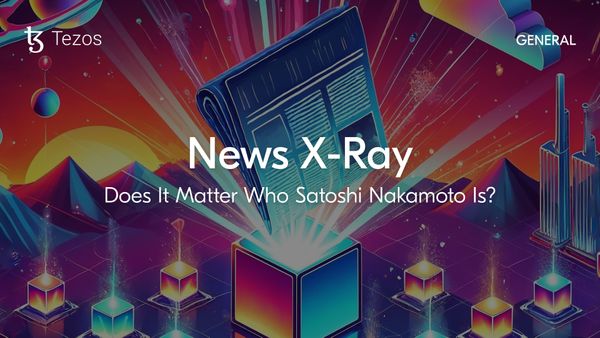News X-Ray: Does It Matter Who Satoshi Nakamoto Is?
A new HBO documentary claims to blow the cover of Bitcoin's creator. But why is Satoshi Nakamoto’s identity such a popular topic?
700 words, 4 minute read

How do you revolutionize both the technology and financial spheres while remaining completely anonymous? Just ask Satoshi Nakamoto. Or, you would if their identity was known to the world. The elusive creator of Bitcoin launched a global technological movement that redefined how we think about money, trust, and decentralization, all while avoiding public identification.
Satoshi’s famous anonymity has fueled fascination, sparking debates about the role of identity and control in crypto. As a new HBO documentary claims that the Bitcoin creator is actually a Canadian developer called Peter Todd, it’s worth reflecting on how projects like Tezos have deliberately not attempted to hide the identity of founders and core developers, and why this is important for the long-term evolution of blockchain as a widely adopted technology.
“It doesn’t matter who Satoshi is, that’s the point. Satoshi was wise to stay anonymous, not just to avoid being a target, but also because the press would have made the entirety of Bitcoin about them and their persona, thereby devastatingly lowering the quality of the discourse.”
Arthur Breitman, Tezos co-founder
The balance between privacy and transparency #
Bitcoin’s initial allure was rooted not only in its technological innovation, but also in Satoshi’s anonymity. Their ability to remain hidden from public scrutiny added, for some, to the appeal of a decentralized financial system that operates without central authority. However, the lingering mystery of Satoshi’s identity has left many commentators and regulators questioning the long-term goals and governance of Bitcoin, despite it having update mechanisms in place (BIPs).

Tezos prioritizes transparency through its governance model, with every proposed change, discussion, and vote visible to network participants, ensuring that stakeholders have a real opportunity to influence the protocol’s direction. Because Tezos, like many other chains, did not begin with an anonymous creator, there is far less attention and speculation dedicated to theorizing what such a mysterious figure might think about updates to the protocol.
The future of blockchain: Navigating identity and regulation #
As speculation about Satoshi’s identity resurfaces, it’s important to ask what lies ahead for the blockchain world. Does unmasking them impact Bitcoin’s future, or does it simply add a human face to a decentralized revolution? Satoshi’s anonymity may have been vital during Bitcoin’s infancy, shielding its creator from media scrutiny and legal threats, but blockchain’s growth trajectory now hinges on trust, adaptability, and inclusivity.
The issue of disjointed regulatory compliance is an area that continues to hold back blockchain adoption in many areas. Bitcoin caught the world by surprise in many respects—governments and regulatory bodies across industries have struggled to adequately respond to the complete paradigm shift that Bitcoin unlocked. As a result, restrictive measures on crypto’s use and classification continue to this day.

Self-amendment processes ensure that networks (like Tezos) can evolve organically in ways that address both regulatory changes and technological advancements without disruption. While Satoshi’s mystery undoubtedly captivates, the real focus should be on creating systems that outlast their creators, emphasizing structure over individualism.
What comes after anonymity in the crypto world? #
HBO taking the matter of Satoshi’s identity beyond Web3 channels and communities and reaching a universal viewership poses a broader question: Does blockchain’s future still need anonymity to succeed? In Bitcoin’s early days, anonymity may have allowed for experimentation free from external pressures. But now, as the industry matures, the focus shifts to trust-building and sustainable growth.
Personality undoubtedly matters. Just look at the figureheads of some of the largest corporations on the planet, and the massive amounts of attention they receive based on their opinions not only about their own businesses, but also about wider political and social topics. Web3 often mirrors this when it comes to the figureheads behind influential projects. It is this attention that can unfortunately skew public perception of the technology itself.
Ultimately, the blockchain space continues to evolve, as does Bitcoin’s role in it. While Satoshi’s anonymity once symbolized the disruptive potential of decentralized technology, projects like Tezos are forging a path where networks can thrive not because of a single visionary, but because of a robust, engaged, and transparent community. The future of blockchain may not be about hiding identities, but about building systems that are resilient, open, and adaptable—where the collective drives progress, not a mysterious figurehead.